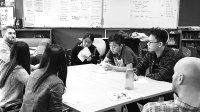Using PBL to Meet C3 Social Studies Standards
Project-based learning aligns with and enhances the College, Career, and Civic Life Framework for Social Studies State Standards.
Your content has been saved!
Go to My Saved Content.Schools within the United States and around the world are in the process of adopting the new College, Career, and Civic Life Framework for Social Studies State Standards, or C3. These standards seek to upgrade existing standards in the states, districts, and schools and to help strengthen the rigor of social studies education.
Our students are naturally curious, and the C3 framework works to foster that curiosity in the implementation of standards with a heavy focus on inquiry. Indeed, it’s easy to find resources that have “Inquiries” aligned to the C3 framework. Examples include kindergarten students investigating “Needs and Wants” using the question “Can we ever get everything we want?” and 10th graders using the question “Does development mean progress?” as they learn about the African countries of Kenya, Botswana, and Algeria.
Project-based learning can be a powerful tool to implement the C3, scaffold inquiries like these, and upgrade such inquiries to be even more authentic and focused on taking action.
PBL and the Four Dimensions of the C3
The C3 has four dimensions: one focused on questioning and inquiry; another on disciplinary knowledge and concepts relating to civics, economics, geography, and history; another on evaluating and using evidence; and a final one on communicating and taking action.
If you’re a PBL teacher, you can see the alignment to PBL. Both PBL and the C3 have a heavy emphasis on inquiry. Indeed, PBL requires sustained inquiry over time via a powerful driving question. PBL also requires students to learn content knowledge and skills in a variety of disciplines. PBL requires students to communicate their ideas through addressing local and global problems and engaging in the authentic work of adults. And PBL puts a heavy emphasis on presentation and connecting with the public.
While the C3 puts a more intentional focus on evaluating sources and using evidence, most PBL teachers would argue that their projects require both. Overall, PBL and the C3 align very well, and PBL can provide a practical framework for implementation of the C3 that truly engages students.
Using PBL to Scaffold Inquiry
PBL doesn’t just engage students in inquiry—it gives students the tools to become skilled inquirers. All projects have a driving question to focus the learning and work. The C3 includes standards that have students write their own “compelling questions” individually and with other students and explain key ideas, questions, and content connecting with their compelling questions. Teachers implementing the C3 can use PBL’s driving questions as their compelling questions to engage students and support their inquiries.
In addition, as students become more skilled inquirers, they can write their own driving questions for projects that are co-created by teacher and students. In addition to the tool of the driving question, the “need to know”—or student question list—can help scaffold the inquiry process. When teachers launch a project, they solicit students’ questions. Students also revisit these questions, revise them, and come up with new questions. PBL can support students learning the skills in this first dimension of the C3.
Essential Disciplinary Knowledge
One possible misconception about the C3 is that one needs to give equal time and attention to every standard included. In fact, the C3 leaves it up to schools to determine what is essential and when it is taught. The C3 provides four subjects in Dimension 2 to focus on—civics, economics, geography, and history—and allows for companion subjects such as anthropology and religious studies. The standards are a framework for teachers and schools to make decisions about what is taught.
As teachers use PBL projects to implement the C3, they must decide what is essential for students to learn. PBL requires a backward design process of identifying content and skills students will learn in the project. Teachers can use PBL to help them focus on the essential learning of the C3 rather than trying to do it all.
Authentic and Meaningful Claims and Evidence
As a project creates a list of “need to know” content and skills, it also creates a need to make claims and use evidence to support those claims. Two teachers in my school recently implemented a project aligned to the C3 framework and the psychology companion subject. In the project, students created guides on the psychology of teen behavior. They developed opinions about how parents, adults, and their peers could work effectively with each other, and used psychological content knowledge and sources to back their ideas up. The project created an authentic need to make claims about working with teams as well as citing important sources to back up those claims.
Authentic Critique, Communication, and Action
Dimension 4 of the C3 requires students to take informed action and communicate their conclusions. Students are required to do this collaboratively and to critique each other’s ideas. PBL likewise includes critique and revision, and students engage in multiple stages of feedback that takes on many forms, including teacher conferences, peer review, and critique protocols.
Also, PBL requires students to share their learning with the public, and the best projects have students actually making a difference in their community. One elementary school project I’ve seen had students investigate important people in their community and celebrate them. Students made presentations and had voice and choice in the person or career they wanted to investigate. PBL provides a context for communicating and taking action that engages students.
PBL is an effective framework that not only aligns to the C3, but upgrades implementation with authenticity, scaffolds inquiry, and focuses on essential learning.
